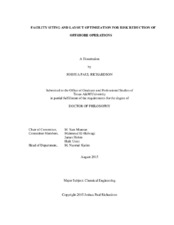| dc.description.abstract | An MINLP optimization model has been created that optimizes the layout of a set of sections with fixed footprint areas bound to an offshore platform of a given size based on safety considerations due to fire, explosion, and toxic scenarios. Process parameters are used to estimate the probability of an event as well as the magnitude of the possible impact on other sections, which can be weighted in importance in the objective. The magnitude of the impact is directly dependent on several factors: the spacing between the sections, the congestion in the general vicinity of the section, escape routes, and domino effects of fire and explosion.
Explosion modeling is carried out both for vapor cloud explosions ignited within the area that they are created, and dispersed flammable clouds with footprints based on weather conditions, congestion, and process conditions. Modeling uses an approximation to the TNO multi-energy method which takes into account the amount of congestion and confinement in the area and the size of the flammable cloud.
Fire modeling is used to ascertain the adequacy of layout of both sections and muster points that the sections are assigned to. Modeling is done using three different correlations for different fire scenarios: pool fire, fireball, and jet fire. Toxic effects of combustion products and escape-hindering effects of smoke production are also incorporated into the model, accounting for weather conditions and local congestion.
Toxic modeling is based on the same dispersion modeling estimation as the explosion and fire scearios use and focuses on the effect of hydrogen sulfide leaks causing incapacitation, escape difficulties due to eye irritation and disorientation, and death.
Dispersion modeling to determine effects of smoke, dispersed gas clouds, and toxic vapors is carried out in three-dimensions using the CFD software FLACS and the anticipated congestion model (ACM), a method that has not yet been applied to generalized dispersion. The results are correlated to an expression as a function of flow rate, congestion, windspeed, and their interactions that can be used in the optimization formulation.
Mitigations are also considered; blast walls and fire walls, both ideal (non-failing) and with failure mechanisms, are incorporated into the model as a key component considered during the layout.
It is shown that the model is a positive step into an area that has sparsely been considered, contributing a framework for the integrated consideration and minimization of several key risk factors in the offshore realm that, as yet, have been unexplored from the numerical optimization viewpoint. | en |


